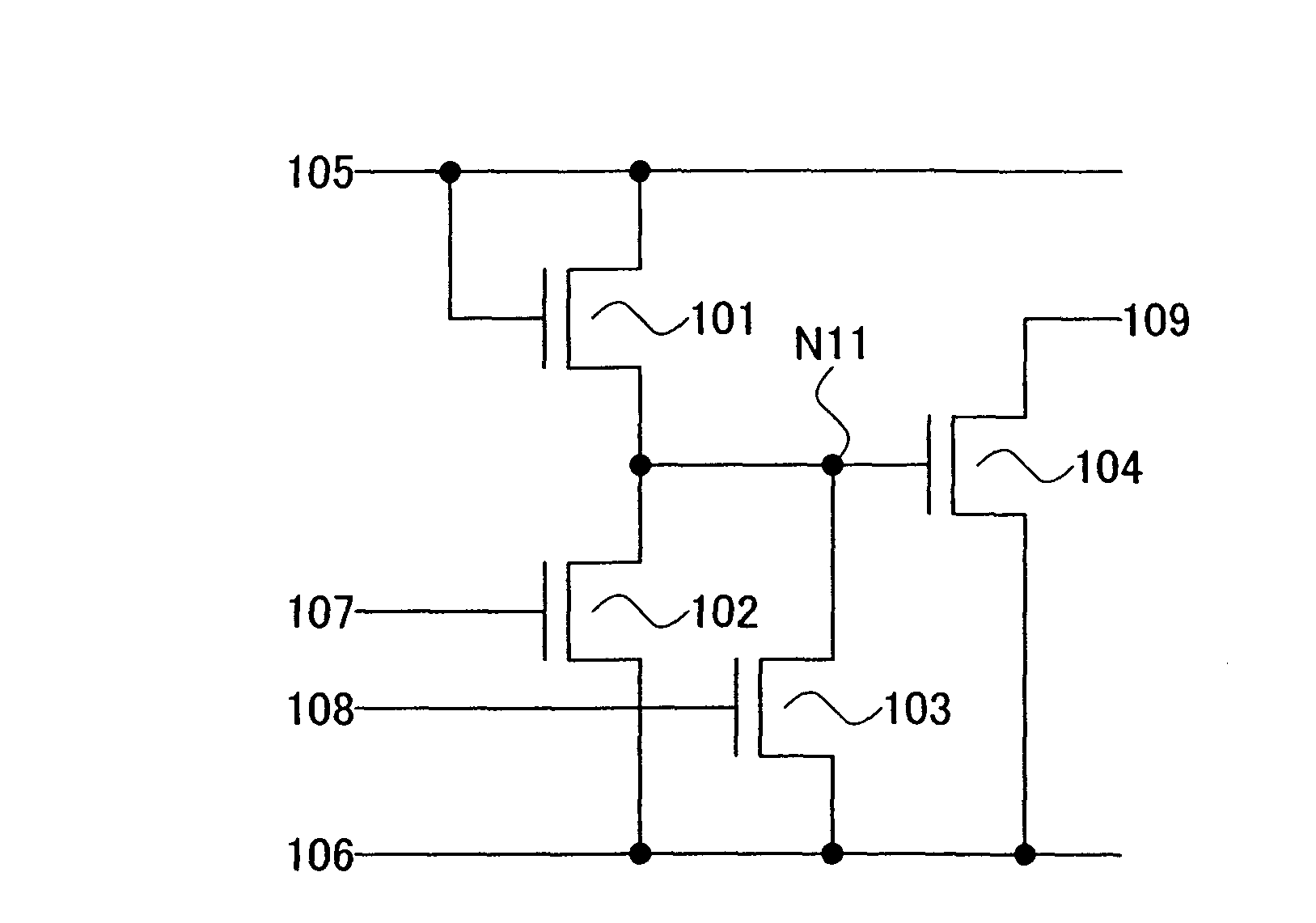Liquid crystal display device and electronic device
a technology of liquid crystal display and electronic device, which is applied in the direction of logic circuit coupling/interface arrangement, pulse technique, instruments, etc., can solve the problems of deterioration of the transistors formed of an amorphous semiconductor, and achieve the effects of low cost, high current supply capacity, and small siz
- Summary
- Abstract
- Description
- Claims
- Application Information
AI Technical Summary
Benefits of technology
Problems solved by technology
Method used
Image
Examples
embodiment mode 1
[0138]In this embodiment mode, a basic principle of the invention is described with reference to
[0139]FIG. 1A.
[0140]FIG. 1A shows a basic circuit which is based on the basic principle of the invention. The basic circuit in FIG. 1A includes a transistor 101, a transistor 102, a transistor 103, and a transistor 104.
[0141]Connection relations of the basic circuit in FIG. 1A are described. A gate of the transistor 101 is connected to a wiring 105, a first terminal of the transistor 101 is connected to the wiring 105, and a second terminal of the transistor 101 is connected to a gate of the transistor 104. A gate of the transistor 102 is connected to a wiring 107, a first terminal of the transistor 102 is connected to a wiring 106, and a second terminal of the transistor 102 is connected to the gate of the transistor 104. A gate of the transistor 103 is connected to a wiring 108, a first terminal of the transistor 103 is connected to the wiring 106, and a second terminal of the transisto...
embodiment mode 2
[0193]In this embodiment mode, a basic principle of the invention which is different from that of Embodiment Mode 1 is described with reference to FIG. 5A.
[0194]FIG. 5A shows a basic circuit which is based on the basic principle of the invention. The basic circuit in FIG. 5A includes a transistor 501, a transistor 502, a transistor 503, a transistor 504, a transistor 505, a transistor 506, and a transistor 507.
[0195]Connection relations of the basic circuit in FIG. 5A are described. A gate of the transistor 501 is connected to a wiring 508, a first terminal of the transistor 501 is connected to the wiring 508, and a second terminal of the transistor 501 is connected to a gate of the transistor 504. A gate of the transistor 502 is connected to a wiring 510, a first terminal of the transistor 502 is connected to a wiring 509, and a second terminal of the transistor 502 is connected to the gate of the transistor 504. A gate of the transistor 503 is connected to a wiring 511, a first te...
embodiment mode 3
[0255]In this embodiment mode, a basic principle of the invention which is different from those of Embodiment Modes 1 and 2 is described with reference to FIG. 9A.
[0256]FIG. 9A shows a basic circuit which is based on the basic principle of the invention. The basic circuit in FIG. 9A includes a transistor 901, a transistor 902, a transistor 903, and a transistor 904.
[0257]Connection relations of the basic circuit in FIG. 9A are described. A gate of the transistor 901 is connected to a gate of the transistor 904, a first terminal of the transistor 901 is connected to a wiring 906, and a second terminal of the transistor 901 is connected to the gate of the transistor 904. A gate of the transistor 902 is connected to a wiring 907, a first terminal of the transistor 902 is connected to a wiring 905, and a second terminal of the transistor 902 is connected to the gate of the transistor 904. A gate of the transistor 903 is connected to a wiring 908, a first terminal of the transistor 903 i...
PUM
 Login to View More
Login to View More Abstract
Description
Claims
Application Information
 Login to View More
Login to View More - R&D
- Intellectual Property
- Life Sciences
- Materials
- Tech Scout
- Unparalleled Data Quality
- Higher Quality Content
- 60% Fewer Hallucinations
Browse by: Latest US Patents, China's latest patents, Technical Efficacy Thesaurus, Application Domain, Technology Topic, Popular Technical Reports.
© 2025 PatSnap. All rights reserved.Legal|Privacy policy|Modern Slavery Act Transparency Statement|Sitemap|About US| Contact US: help@patsnap.com



